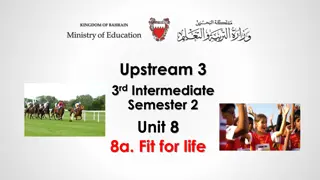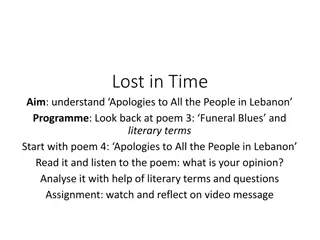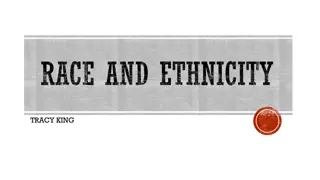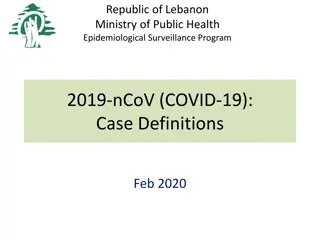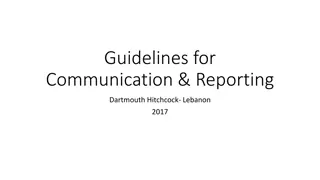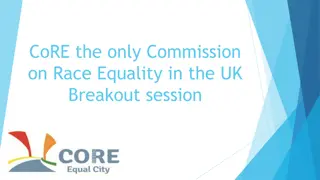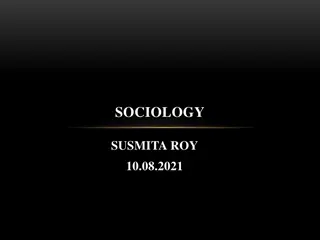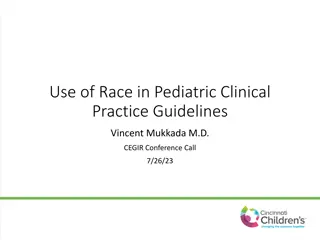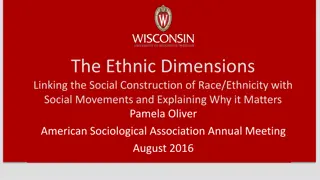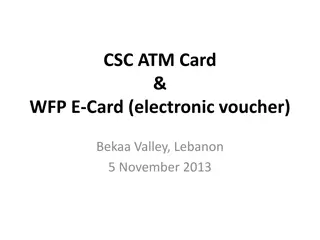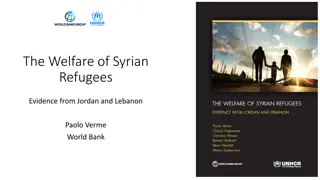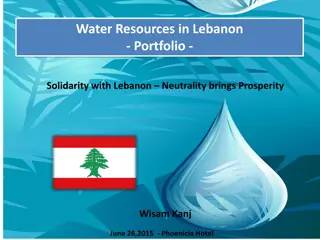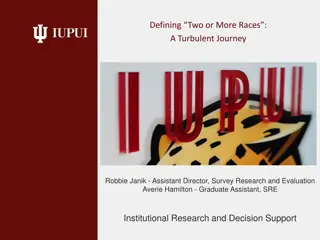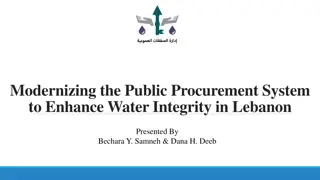Lebanon RACE II Program for Education Improvement
The Lebanon RACE II program aims to enhance access, quality, and overall effectiveness of education systems for children and youth. Through pillars focusing on access, quality, and system strengthening, the program addresses various aspects such as improving educational services, learning environments, and governance capacities. Outputs include supporting demand for education, enhancing teacher capacities, promoting safe learning environments, and implementing interactive curriculum. The ultimate goal is to provide equitable access to quality education opportunities for all, while strengthening the education system at all levels.
Download Presentation

Please find below an Image/Link to download the presentation.
The content on the website is provided AS IS for your information and personal use only. It may not be sold, licensed, or shared on other websites without obtaining consent from the author.If you encounter any issues during the download, it is possible that the publisher has removed the file from their server.
You are allowed to download the files provided on this website for personal or commercial use, subject to the condition that they are used lawfully. All files are the property of their respective owners.
The content on the website is provided AS IS for your information and personal use only. It may not be sold, licensed, or shared on other websites without obtaining consent from the author.
E N D
Presentation Transcript
Lebanon RACE II: Environmental and Social Systems Assessment (ESSA) Consultation Workshop Beirut, April 21, 2016
Program Objective The Project Development Objective would be to support the RACE 2 program to provide equitable access to quality education opportunities for all children and youth. This will be achieved through three pillars: Improved access to education opportunities, Improved quality of education services, and Improved education systems
RACE 2 Program Pillars ACCESS: Enhanced access to, and demand from, children and their care-givers; for equitable formal or non-formal education pathways QUALITY: Enhanced quality of education services and learning environments provided, to ensure relevant, age- appropriate learning outcomes for children SYSTEM STRENGTHENING: Enhanced governance and managerial capacities of the MEHE and its institutions to plan, budget, deliver, monitor, and evaluate education services
RACE 2 Program Outputs A. ACCESS: A.1: Girls, boys, and their caregivers are provided with the necessary support to increase their demand for certified formal education or non-formal learning opportunities A.2: Girls and boys are equitably provided with increased access to appropriately equipped public schools and non-formal learning spaces
RACE 2 Program Outputs B. QUALITY: B.1 Teachers and educational personnel have improved capacities to provide learner-centred teaching in formal schools or non-formal spaces B.2 Educational personnel at the school-level are capacitated and empowered to proactively provide safe and enabling learning environments B.3 Communities are capacitated to actively engage in the promotion of learning and well-being of students and children in learning spaces B.4 Appropriate systems are effectively deployed to improve the monitoring and evaluation of teaching quality, learning outcomes, and learning environments
RACE 2 Program Outputs C. SYSTEM STRENGTHENING: C.1: MEHE and its institutions manage an effective and accurate education information-management system C.2: A revised, interactive curriculum is implemented in schools and learning spaces to improve quality learning, life-skills and employability for children and youth C.3: Appropriate policies are endorsed and implemented to regulate education programmes and services, strengthen school management, and professionalise teaching services, in formal schools and learning spaces C.4: MEHE and its institutions at central and regional level are strengthened to lead and coordinate the planning, implementation, and evaluation of the RACE II Strategy
ESSA Objectives The Environmental and Social Systems Assessment (ESSA) is crucial to ensure that PforR operations are designed and implemented in a manner that maximizes potential environmental and social benefits. ESSA assesses the borrower s authority, organizational capacity and performance to date, to achieve the social and environmental objectives associated with the Program and stipulates supplementary actions as necessary through: (i) identifies what the relevant environmental and social risks are and why, (ii) understands what the potential impacts of the program may be, (iii) identifies if there are any legacy issues that may influence the program design and implementation, and (iv) propose actionable improvements in managing such risks.
Environmental and Social Risks Environmental Risks The assessment of environmental and social risk level associated with the Program is considered to be moderate. No major environmental impacts and risks are anticipated. It is envisaged that the Program will not be including any of Category-A type investments, nor will be posing any risk on natural habitats or on physical cultural resources. Program will not include activities that could potentially generate considerable pollution to any environmental media or that would pose any risks to land use or to natural resources. Social Risks Social risk associated with land acquisition, compensation and resettlement are also considered to be moderate. The RACE II Program should contribute to improving the national system of environmental and social assessment, public information and consultation, grievance redress mechanisms, and procedures for land acquisition, voluntary land donation, and resettlement. However, social risks associated with discrimination, bullying and social cohesion, particularly affecting refugees are considered to be substantial. Safety and security related issues as they affect Syrian youth, men, women, and other vulnerable groups, and impediments to registration in schools are also prevalent. The ESSA recommendations attempt to minimize social risks by putting in place clear, objective and transparent criteria in place to address these to be implemented with throughout Program implementation.
Environmental Risks The main environmental risks of RACE II investments (communities/teachers/students) fall under the implementation of Component 1 Access: classroom rehabilitation and/or expansion of the number of classrooms during implementation. Minor environmental risks of RACE II investments (communities/teachers/students) fall under the needs assessment and the operations and maintenance of Component 1 Access.
Environmental Risks Based on the scope and scale of projects, environmental impacts will be site-specific and temporary. Potential adverse environmental effects include air pollution from dust and emissions (heavy equipment, generators, etc.); nuisances such as noise; solid and liquid wastes from construction sites/worker campsites; soil erosion and possible traffic interruptions. These can be prevented or mitigated with standard operational procedures and good construction management practices which will increase worker safety and reduce environmental pressures.
Social Assessment The social and political issues play an important role in the education sector. Several social groups make up society in Lebanon today Confession Geography Social class Political party Gender Youth Refugee/non-refugee Needs priorities and interests vary depending on the social group. Yet social groups overlap, making priorities and interests complex to identify.
Social Assessment: Gender and Youth Gender equality: Lebanon is 8th worst country in gender equality (134th out of 142). Poor performance in terms of political empowerment (the Global Gender Gap Index measures the relative gaps between women and men across four key areas: health and survival, education attainment, economic participation, and political empowerment). Economic participation: relatively low levels of female participation in the workforce (female to male ratio of 0.34 - 133 out of 142 countries) Youth are particularly vulnerable: 34% youth unemployment is among the highest in the region Mostly disengaged from the political process and demotivated to impact any real change in Lebanon due to economic and political situation.
Social Assessment Refugees and non- refugees Non-refugees Concerns about security and violence in schools Concerns about overcrowding Lower quality of education Refugees Higher share of women and children among the refugee population, and higher share of people in psychological distress. Early signs of vulnerability and negative coping strategies (mobility, debt, asset selling, child labor, early marriage, begging, etc.) are prevalent among the Syrian population When the Lebanese poverty rate is used, 9 out of 10 refugees are below the poverty line Young people are more likely to resort to violence, including sexual violence, to criminal activities, or to substance abuse
Social Assessment Refugees and non- refugees Syrian refugees also have specific vulnerabilities: mostly come from poorer than average areas of Syria, as compared to the host population Syrian refugees tend to have larger families have lower than average education levels, and have fewer assets higher share of women and children among the refugee population higher share of people in psychological distress negative coping strategies (mobility, debt, asset selling, child labor, early marriage, begging, etc.) are prevalent among the Syrian population
Social Assessment: Impacts of the Syrian Crisis Conflict has had a significant impact on Lebanese society since 1975 civil war Syrian conflict further divides social groups within Lebanon, as now opposing Lebanese confessions support different sides in the Lebanese conflict Deteriorating security environment Strained capacity of key infrastructures including, water, sanitation, electricity and solid waste management and municipal services, including in terms of access, distribution and quality
Social Assessment : Education Large number of Syrian refugee children (1 out of ten people in Lebanon in a Syrian refugee child) has led to overcrowding in some public schools and to different curricula used to accommodate the needs of Lebanese and Syrian children Quality of learning for all children has been negatively affected Bullying occurs when refugees attend the morning shift, or when non- refugee students attend the second shift Fear of violence and social acceptance challenges Road blocks to attend school: Registration permits Residence permits Safe transportation Education levels are correlated with having better jobs, although constraints and a lack of connections may inhibit labor mobility and job access
Social Risks / Social benefits The social impacts of the program will depend on the mechanisms and processes of implementation, including measures for transparency and citizen engagement. Impacts include: Impacts on the trust between citizens and the state Impacts on relationship between host and refugee communities. Impacts on patronage networks Impacts on levels of exclusion among certain groups. Impacts will depend on: Targeting Transparency Effectiveness Specific activities supported
Social Risks: land acquisition Infrastructure support may require land acquisition or the change in usage of land and property for the construction of schools This may affects people who will lose their productive assets or income sources due to involuntary resettlement No resettlement will be permitted under the program
Environmental Benefits Environmental health benefits are in terms of improving occupational health of workers during construction and improving the ambient (healthy) environment of administrators, teachers and students in terms of transmission of traditional diseases (better heating, water, sanitation and solid waste operations and management) during and after school rehabilitation and/or construction. Environmental benefits are in terms of reducing pressures (air, noise and liquid/solid waste) on the environment during and after school rehabilitation and/or construction.
Policy and Legal Framework: Environmental Impacts The Environment Protection Law 444/2002 includes the Environmental Impact Assessment (EIA) Decree no. 8633/2012 which is a preventive tool for predicting and mitigating adverse impacts in projects. School Rehabilitation and/or reconstruction fall under the Initial Environmental Examination (IEE). The Ministry of Environment has a hotline and an email address for complaints: Hotline for Complaints : 1789 Complaint email: complaints@moe.gov.lb
Policy and Legal Framework: Environmental Impacts The MOE through its service of Environmental Technology has the prerogatives to screen, review, control and follow up on the IEE/EIA process and its implementation. The approval of an EIA is a pre- requisite for any subsequent license or permit by any or all other relevant authorities that may be required prior to construction. According to Decree no. 8633/2012, IEEs do not require consultations whereas EIAs do.
Policy and Legal Framework: Social Impacts Law 422 of 2002 Entitles a child to legal protection if threatened or at risk; a child in a situation that exposes him/her to exploitation, or threatens his/her health, safety, morals, or upbringing; a child exposed to sexual abuse or physical violence that exceeds non-harmful, culturally acceptable disciplinary beating; Article 41 Decision 1130 of 2001 Regulation of preschools and basic education in public schools stipulates that employees in the education sector are prohibited to inflict any physical punishment on pupils, nor to address verbal retribution that is humiliating and is against the principle of education and personal dignity.
Policy and Legal Framework: Social Impacts Expropriation Law No. 58 dated 29/05/1991 (amended on 8/12/2006): The State may only expropriate rights when it is to be declared in the public interest, and against payment of a prior and equitable compensation ( indemnit equitable ). All compensation is financial award through legal assessment, and the process of expropriation itself cannot be halted unless the validity of the public interest decree itself is challenged Compensation is determined by the Expropriation Commission set up by a decree according to proposals from the relevant ministers. The decisions of the Preliminary Commission may be appealed to the Appeals Commission by the MEHE or the individual property owner and the appellant must be represented by a lawyer.
Policy and Legal Framework: Social Impacts Tenancy Law: The rent law enacted in 1991 gives the land owner the right to retrieve the property at the end of the contract. Where expropriation causes loss of tenancy, expropriation commissions divide their awards between landlords and tenants according to the economic value of the tenancy, enabling tenants to secure alternative housing by rental or down payment for purchase. Land Tenure: Limited contestation over ownership, legal rights or boundaries of land because plots are generally well surveyed and title is recorded at an administrative service based in the Ministry of Finance (with the exception of areas affected by uncontrolled movement and settlement due to the civil war); exact value of the land can be determined.
Policy and Legal Frameworks: Social impacts Complaints Handling in Ministry of Education The MEHE hosts a Hotline [number 01772101]. The Hotline is responsible for receiving complaints that are forwarded to the Director General at MEHE who will process and resolve them.
Policy and Legal Frameworks: Social Impacts Antiquities Law: According to the Antiquities Law of 1933, historic monuments, even those on the General Inventory List, can be either publicly or privately owned. Although archaeological finds are considered state property, the parcels on which archaeological discoveries are made can remain the property of private individuals or institutions. Maritime Public Domain: Lebanese Law provides that the entire intertidal shore is public domain. This law has not been fully enforced. If a certain number of semi-permanent informal business structures have been erected, the owners will be assisted to relocate their businesses outside the Right of Way (ROW).
Capacity Assessment of Institutions: Environment The existing systems for environmental management in Lebanon was analyzed for consistency with the core principles of OP/BP 9.00. Lebanon EIA system is aligned with World Bank s requirements except for few gaps that could be bridged by updating the TORs for school rehabilitation and/or construction that will build on the Environmental Management Plan and Guidelines for the World Bank Education Development Project 2 (EDP II)/Emergency Education System Stabilization Project (EESSP) and by disclosing the EIA including consultation to the public on the MEHE website.
Capacity Assessment of Institutions: Environment The MOE has adequate capacity to screen and review IEEs/EIAs, nevertheless, the MOE does not have adequate resources to monitor the IEE/EIA during rehabilitation and/or construction.
Capacity Assessment of Institutions: Environment Under Race II: All school rehabilitations will be required to perform an IEE with its disclosure to be posted on the MEHE website. Any hazardous material (e.g., Eternit roof cover) found during the initial screening will necessitate the preparation of a full EIA. All school reconstructions will be required to perform an EIA with its disclosure to be posted on the MEHE website. For rehabilitation, a walk-in due diligence will be conducted to bring toilets, labs, waste management, power generator, heaters, etc. are environmentally and hygiene quality standards. Monitoring of IEE during rehabilitation and EIA during construction will need to be covered by the PMU.
Capacity Assessment of Institutions: Social Lebanese Law 422 of 2002 Law 422 has a number of important limitations. First of all, the law is essentially a juvenile justice law, not a comprehensive child protection law, and is therefore infrequently applied for child victims. Secondly, the law does not provide a series of welfare service measures, but creates a last resort response mechanism for children already in crisis. Article 41 of Decision no. 1130/m/2001 The Decision does not provide specifics about student rights nor accountability of teachers and other education staff. The lack of clarity in terms of grievance redress mechanisms at the school level, and a transparent system of reward and sanction for misbehavior poses a challenge to the social dynamics at the school level.
Capacity Assessment of Institutions: Social Complaints Handling in Ministry of Education No information management system to record the complaints therefore systematic handling (registering, follow up, feedback, appeal and resolution) are absent. No benchmark of information to assess performance, nor a process that can be tracked, and therefore resolved.
Capacity Assessment of Institutions: Social There are gaps between the Expropriation Law Expropriation Law No. 58 dated 29/05/1991 (amended on 8/12/2006) and the World Bank Policy OP 4.12 in the following areas: Extent of stakeholder consultation/participation in the resettlement process (no prior public debate in Lebanese system); Payment of compensation (Full payment is made after the take over of the land); Squatters and occupants without legal rights (only those with legal rights are compensated)
Recommendations and Proposed Action Plan: Environment Mitigation and monitoring measures will build on the existing Environmental Management Plans and Guidelines of EDP II and EESSP. Monitoring measures are for the categories considered under the mitigation categories for the associated parameters in terms of: what, where, how, when and how much. Institutional Strengthening plans are considered to avoid negative environmental impacts by architects and engineers; architectural/construction project documentation. Training of MEHE engineers will be offered before effectiveness.
Recommendations and Proposed Action Plan: Environment For Rehabilitation: The contractual agreement will include Environment, Health (onsite worker safety, etc.) and Safety Specifications (EHSS) and Environmental and Social Management Plans (ESMP) to mitigate for any negative environmental and social impact during rehabilitation. For Construction: The TORs for EIA will include an ESMP to mitigate for any negative environmental and social impact during construction. The contractual agreement will include EHSS and ESMP to mitigate for any negative environmental and social impact during rehabilitation
Establish a Grievance Redressal System Strengthen existing channels and establishing complementary channels to address discrimination, bullying and harrassment Transparency on program rules, outreach, and communication activities in program activities: Systematic dissemination of information of program, services, rights, and grievance systems RECOMMENDATIONS AND PROGRAM ACTION PLAN SOCIAL Develop Action Plan for Social Risk Management Develop guidelines and policies for improving safe environments PMU Capacity of environmental and social management systems Development of standard operating procedures and assignment of function
Recommendations and Action Plan: Social Establish a Grievance Redress System (GRM) Strengthen the grievance redressal system at the MEHE Hire a Grievance Redress Officer at the PMU level Strengthen handling of gender-based violence complaints Increase the Uptake channels for complaints through field officers, psycho-social counsellors; grievance officer
Recommendations and Action Plan: Social Transparency on program rules, outreach, and communication activities throughout program activities Effective communication strategies at national and local levels on i) program objectives, ii) targeting methods, iii) resource distribution, and iv) grievance redress systems Systematic dissemination and publicly available information to children, care-givers, and community-leaders for informed decision-making on education opportunities Awareness raising of all PMU staff, community liaisons, and psycho-social counsellors about targeting criteria, resource distribution, and grievance redress systems
Recommendations and Action Plan: Social Develop Action Plan for Social Risk Management Activities Develop guidelines and train field coordinators on social risk management Operationalizing policies to promote safe learning environments in schools and non-formal learning spaces Support the development of national frameworks for protecting children and promoting safe and conducive learning environments Provide community level opportunities for children and care givers
Recommendations and Action Plan: social Strengthen the PMU s capacity for environmental and social management and monitoring capacity Standard Operating Procedures for PMU before the start of the Program for social risk management Assignment of social management function within PMU to one of its staff Application by PMU of applicable procedures for voluntary land donation as defined in Operational Manual Establishing a grievance redress mechanism to handle complaints associated with land acquisition and resettlement Monitoring of complaints and land acquisition Environmental and social reporting


